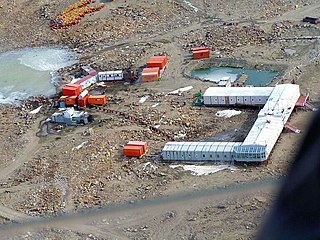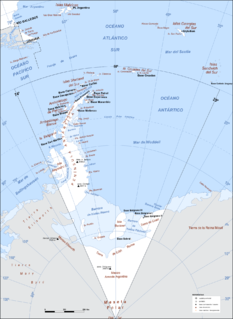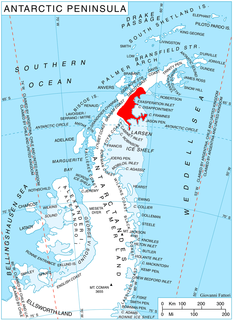Related Research Articles

The Indian Antarctic Programme is a multi-disciplinary, multi-institutional programme under the control of the National Centre for Polar and Ocean Research, Ministry of Earth Sciences, Government of India. It was initiated in 1981 with the first Indian expedition to Antarctica. The programme gained global acceptance with India's signing of the Antarctic Treaty and subsequent construction of the Dakshin Gangotri Antarctic research base in 1983, superseded by the Maitri base from 1989. The newest base commissioned in 2012 is Bharati, constructed out of 134 shipping containers. Under the programme, atmospheric, biological, earth, chemical, and medical sciences are studied by India, which has carried out 30 scientific expeditions to the Antarctic as of 14 October 2010.

Argentine Antarctica is an area of Antarctica claimed by Argentina as part of its national territory. It consists of the Antarctic Peninsula and a triangular section extending to the South Pole, delimited by the 25° West and 74° West meridians and the 60° South parallel. This region overlaps the British and Chilean claims in Antarctica. Argentina's Antarctic claim is based on its continued presence in the region since 1904, and the area's proximity to the South American continent. Argentina's claim to this area is subject to the Antarctic Treaty. Administratively, Argentine Antarctica is a department of the province of Tierra del Fuego, Antarctica, and South Atlantic Islands. The provincial authorities are based in Ushuaia. Despite the claim to this Antarctic area, Argentinean authority extends no further than the nation's bases. The Argentine exploration of the continent started early in the 20th century. José María Sobral was the first Argentine to set foot on Antarctica, in 1902, where he spent two seasons with the Swedish Antarctic Expedition of Otto Nordenskiöld. Shortly afterward, in 1904, the Orcadas permanent base was already fully operational. Years later other bases would be created, some permanent and others seasonal. The first Argentine expedition to reach the South Pole was the 1965 Operación 90.

Bunger Hills, also known as Bunger Lakes or Bunger Oasis, is a coastal range on the Knox Coast in Wilkes Land in Antarctica, consisting of a group of moderately low, rounded coastal hills, overlain by morainic drift and notably ice free throughout the year, lying south of the Highjump Archipelago. The reasoning behind the minute amount of ice in the area is still relatively unknown and remains under intense debate amongst scientists today.

Henryk Arctowski Polish Antarctic Station is a Polish research station on King George Island, off the coast of Antarctica.
The Soviet Antarctic Expedition was part of the Arctic and Antarctic Research Institute of the Soviet Committee on Antarctic Research of the Academy of Sciences of the USSR.

Base Presidente Eduardo Frei Montalva is the most important Antarctic base of Chile. It is located at Fildes Peninsula, an ice-free area, in front of Fildes Bay, west of King George Island, South Shetland Islands. Situated alongside the Escudero Station and only 200 metres from the Russian Bellingshausen Station, its geographic coordinates are 62°12′0″S58°57′51″W, at an altitude of 10 metres above sea-level. The base is located in the Chilean commune of Antártica, which is the Antarctic territory claimed by Chile.

Henryk Arctowski, born Henryk Artzt, was a Polish scientist and explorer. Living in exile for a large part of his life, he was one of the first persons to winter in Antarctica and became an internationally renowned meteorologist. He was instrumental in restoring Polish independence after the First World War. Several geographical features, the Henryk Arctowski Polish Antarctic Station and a medal of the National Academy of Sciences are named in his honor.

Antoni Bolesław Dobrowolski was a Polish geophysicist, meteorologist and explorer.
Arctowski Cove is a small cove at the southeast side of Point Thomas in Admiralty Bay, King George Island. Named by a Polish Antarctic Expedition (1977–79) after Henryk Arctowski, Polish meteorologist with the Belgian Antarctic Expedition, 1897–99, and in association with the Henryk Arctowski Polish Antarctic Station on Point Thomas.

The Schirmacher Oasis is a 25 km long and up to 3 km wide ice-free plateau with more than 100 freshwater lakes. It is situated in the Schirmacher Hills on the Princess Astrid Coast in Queen Maud Land in East Antarctica, and is on average 100 metres above sea level. With an area of 34 km², the Schirmacher Oasis ranks among the smallest Antarctic oases and is a typical polar desert.

Baranowski Glacier is a glacier flowing east into Admiralty Bay, King George Island, northwest of Demay Point. It was named by the Polish Antarctic Expedition after Stanisław Baranowski (1935–78), Polish glaciologist who died on King George Island as a result of an accident at the Henryk Arctowski Polish Antarctic Station while a member of the 1977–78 expedition.

Polar Club Glacier is a broad glacier east-northeast of Stranger Point, King George Island, in Antaratica. South of it is Bransfield Strait. Named by the Polish Antarctic Expedition, 1980, after the Polish Polar Club.

Ecology Glacier is a glacier flowing northeast into Admiralty Bay, King George Island, north of Llano Point. It was named by the Polish Antarctic Expedition, 1980, after the Institute of Ecology of the Polish Academy of Sciences, the sponsor of nearby Arctowski Station.
Gdynia Point is the eastern point of Dufayel Island, lying in Ezcurra Inlet, Admiralty Bay, King George Island, in the South Shetland Islands. It was named in 1979 by the Polish Antarctic Expedition after Gdynia, Poland, a port city on the Baltic Sea.
Klekowski Crag is a rock crag rising to about 400 metres (1,300 ft) on the south side of Lange Glacier, Admiralty Bay, King George Island, in the South Shetland Islands. It was named by the Polish Antarctic Expedition in 1979 after Professor Romuald Klekowski, Director of the Institute of Ecology, Polish Academy of Sciences, which sponsored Arctowski Station on King George Island.

Starbuck Glacier is a glacier 15 nautical miles (28 km) long, flowing east along the south side of Taridin Ridge and Padesh Ridge, and entering Scar Inlet immediately north of Mount Queequeg, on the east coast of Graham Land. Surveyed and partially photographed by the Falkland Islands Dependencies Survey (FIDS) in 1947. The entire glacier was photographed by the Falkland Islands and Dependencies Aerial Survey Expedition (FIDASE) in 1955–56, and mapped from these photos by the FIDS in 1957. Named by the United Kingdom Antarctic Place-Names Committee (UK-APC) after the first mate on the Pequod in Herman Melville's Moby-Dick.

Rakusa Point is a point 0.5 nautical miles (0.9 km) southeast of Point Thomas, Admiralty Bay, on King George Island, South Shetland Islands. Named by the Polish Antarctic Expedition in 1977 after Stanislaw Rakusa-Suszczewski, who established Poland's Arctowski Station near this point, February 26, 1977.
Stanisław Baranowski was a Polish glaciologist and leader or member of a number of scientific expeditions to Spitsbergen and Antarctica. He died as a result of an accident near the Henryk Arctowski Polish Antarctic Station while on expedition. At the time of his death, he was head of the Department of Metereology and Climatology at the University of Wrocław.

Miron Babiak,, was a Polish sea captain, who is best known for commanding Prof. Siedlecki Antarctica research ship.

A.B. Dobrowolski Polar Station is a occasionally active Polish polar research station in Antarctica. It is located at the edge of the Algae Lake, Bunger Hills region in the Wilkes Land and was originally constructed by the Soviet Union. It is one of the two Polish stations in Antarctica, the other being the Henryk Arctowski Polish Antarctic Station.
References
Coordinates: 62°09′S58°28′W / 62.150°S 58.467°W